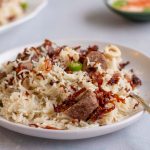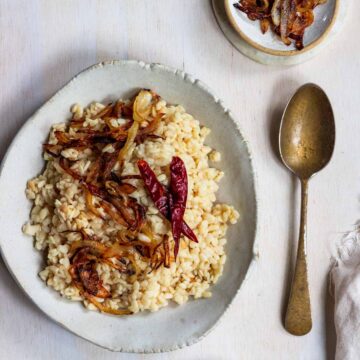Yakhni pulao is a Pakistani and Indian rice dish made with meat and rice that is cooked in an aromatic stock flavoured with whole spices. Today I am sharing a recipe of mutton yakhni pulao which is made using goat meat (known as mutton in the Indian subcontinent). Read on ahead for my tips on how to make a delicious mutton yakhni pulao. Serve with lots of fried onions on top and raita on the side.
An early Eid Mubarak to everyone!
The recipe that I want to share with you today is an Eid family favourite - my mother’s mutton yakhni pulao (goat meat pilaf) that she would make every year for Eid lunch. The lunch menu would change from year to year but the one constant and most requested item would be my mother’s mutton pulao or mutton yakhni pulao, and the recipe I am sharing today. The first time I made this pulao on my own, I was super scared because I was worried it would be a failure. It’s one of my mother’s signature recipes, so super high expectations attached to this recipe but thanks to her precise measurements and tips and tricks, I was able to make it well enough. Read on ahead for the recipe including all her tips and tricks to make the best mutton yakhni pulao.

What is traditional mutton yakhni pulao?
Pulao, pilau or pilaf is a rice based dish which involves cooking meat, vegetables or both in a stock or broth with spices. The origin of pulao can be attributed to the Mughals who brought this style of cooking all the way from Persia to the Indian subcontinent and since then it’s become a popular dish in both India and Pakistan. There are many versions of pulao and one such variant is the mutton yakhni pulao which involves cooking goat meat (known as mutton in the Indian subcontinent) with Basmati rice in an aromatic stock seasoned with spices. In fact, yakhni is the Urdu / Hindi term for stock or broth.
How to make Pakistani and Indian style yakhni pulao?
There are two main steps to making yakhni pulao. The first step is to boil the meat (in this case mutton) with whole ginger, garlic cloves, onions and spices that are bound together in a potli or what is known as a bouquet garni. I have used mutton or goat meat in this recipe but lamb, beef and even chicken can be used as well. Just make sure to use bone-in pieces for added flavour. The entire mixture is cooked on low heat till the meat is tender and the yakhni / stock is infused with flavour. Once the meat is tender, the meat pieces are removed and set aside, the yakhni / stock is strained and reserved for the next step and the spices are thrown away.
In the next step the meat is fried with onions, whole spices and yoghurt after which Basmati rice and that beautifully seasoned yakhni / stock is added. The meat and rice are first cooked on medium heat till the water is almost absorbed and then cooked on low heat with the lid covered (on dum as we call it in Urdu / Hindi) till all the yakhni / stick is absorbed by the rice. My mother has always told me that the beauty of a pulao is how separate the rice grains are from each other. In fact, I was reading the book Curry, an excellent book by Lizzie Collingham about the way food has evolved in the Indian subcontinent. She states that “the Persians judged the quality of a pilau by the rice, which was supposed to swell up completely, but without becoming sticky and forming clumps”
Once the pulao is ready, garnish it with lots of fried onions and serve it with raita (recipe here).

Tips to make mutton yakhni pulao:
The following tips will work for all types of pulao (beef, lamb, chicken) not just mutton pulao.
- Get the best quality ingredients. There are no powdered spices used as such in a pulao, only whole spices that are mainly used to infuse flavour into the rice and meat. If poor quality meat and rice are used, it is unfortunately quite evident. Get fresh meat from the butcher making sure there is no smell in the meat, and get bone-in pieces of mutton (goat meat) because the bones add flavour to the stock. Other than the meat, use good quality aged Basmati rice as that has a better flavour and aroma.
- One of the signs of an excellent mutton yakhni pulao is the whiteness of the rice grains. Key to that is of course good quality Basmati rice. Another thing that helps is frying off the onions and then removing them before adding the mutton. The addition of brown onions at the end ensures that they don’t add a cream-ish tint to the rice.
- Another key sign of a good mutton yakhni pulao is the absorption of the entire yakhni / stock by the rice leading to rice grains that are separate and not mushy. Make sure that almost all of the yakhni / stock has been absorbed by the rice before putting it on dum. Just enough liquid needs to remain to be fully absorbed in the last stage of cooking. In case you put the dum on and realise there is still too much liquid, remove it using a spoon from the side or dab a kitchen towel on top of the rice to absorb excess moisture. Of course, if there’s not enough liquid just sprinkle a few drops or teaspoons on top of the rice to moisten as necessary.
Looking for more Pakistani & Indian recipes for your weekly dinner inspiration. Check out the following:
- Ginger Chicken, Pakistani style
- Murghi ka Salan (Chicken curry with Onions and Tomatoes)
- Karahi Chicken
- Chicken kofta curry (Pakistani style chicken meatball curry)
- Aloo Gosht (Mutton Curry with Potatoes) – Stovetop & Pressure Cooker method
- Traditional chicken korma
📖 Recipe
Yakhni Pulao | Mutton Yakhni Pulao | Goat meat pilaf
Ingredients
For the mutton yakhni / stock:
- 2 tablespoons fennel seeds saunf
- 2 tablespoons whole coriander seeds sabit dhaniya
- ½ kg bone-in small mutton pieces (preferably leg or shoulder meat) goat meat
- 1 medium onion cut into quarters
- ½ garlic pod
- 1 inch piece ginger
- 2 bay leaves tez patta
For the rice:
- ¼ cup oil
- 2 onions sliced
- ½ teaspoon black cumin seeds shah zeera or kala zeera
- ½ teaspoon cumin seeds zeera
- 6 cloves
- 2 cinnamon sticks
- 2 black cardamom
- 10 - 12 black peppercorn
- 2 tablespoons ginger garlic paste
- 2 tablespoons yoghurt
- ½ kg basmati rice
- 4 green chili
- ½ teaspoon screwpine essence (kewra- optional)
- ½ teaspoon yellow food colour (zarday ka rang- optional)
Instructions
For the mutton yakhni / mutton stock:
- Place the fennel seeds and whole coriander seeds in a clean piece of muslin cloth (known as malmal ka kapra in Urdu / Hindi) and tie a knot around it, or tie it tightly with cotton thread. This is known as potli in Urdu or bouquet garni in English. In case muslin cloth isn’t available, a tea infuser ball can also be used. Just make sure it’s the right size.
- Take a large pot and place mutton pieces, onion cut into quarters, garlic cloves, ginger, salt and bay leaves in it. Add the bouquet garni of spices along with about 7 - 8 cups of water. Bring the mutton to a boil and turn heat to low. Boil the mutton on low simmer till it is tender (about 1 - 1 ½ hours) and around 4 - 5 cups / ½ litre of yakhni / stock is left. The mutton will be cooked for about 10 minutes in the next step so it needs to be tender but not super tender else it will break apart.
- Drain the mutton in a colander making sure to reserve the yakhni / stock in a large bowl. Throw away the bouquet garni of spices along with onion, ginger and garlic reserving the mutton pieces.
For the rice:
- Clean and wash the basmati rice. Soak for around ½ hour.
- Heat oil in a large pot and add sliced onions.
- Fry till they are golden brown and crispy and remove with a slotted spoon. Drain the onions on a kitchen towel - as they cool they will crisp up further. Removing the onions at this step and adding them in the end will ensure the colour of the rice is more white versus cream.
- Heat up the same oil and add the whole spices - cloves, cumin seeds, black cumin seeds, cinnamon stick, black cardamom and black peppercorn.
- Fry off the whole spices for a minute and then add the ginger garlic paste.
- After frying off the ginger garlic paste add the mutton pieces followed by yoghurt. Fry for about 5 - 10 minutes till the water dries off.
- At this point add the soaked and drained rice along with ½ litre (4 - 4.5 cups) of the yakhni / stock. The yakhni / stock liquid needs to be in the same ratio as the quantity of rice used, so measure accordingly. In case there isn’t enough yakhni / stock add water and if there is too much yakhni / stock then reserve the remainder. Don’t throw it away as it can be drunk as a mutton soup.
- Bring the mutton and yakhni / stock mixture to a boil and cook on low - medium till the water is almost evaporated from the top.
- At this point, add green chilies and yellow food colour (if using) along with kewra essence (if using).
- Close the lid on the pot and cook on low simmer (dufor about 10 - 15 minutes till the rice is done. You can tell when the pulao is done when all the water is absorbed from the sides. Some of the rice grains will still be sticky but let the rice sit for around 10 minutes, and the rice will be separated.
- To serve, dish out the rice and garnish with the fried onions. Serve with raita on the side.
Notes
Nutrition








Ben says
Thank you for sharing an authentic recipe of mutton pulao.
haris khan 001 says
this artical is really good